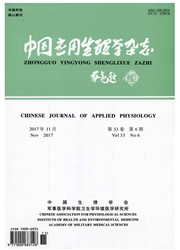

 中文摘要:
中文摘要:
目的:探讨人参皂甙Rg1对6-羟基多巴(6-OHDA)制备的去卵巢(OVX)帕金森病(PD)模型大鼠黑质(SN)多巴胺能神经元的保护作用及其可能机制。方法:应用6-OHDA制备的OVX PD模型大鼠,侧脑室给予Rg1或雌激素。免疫组织化学染色酪氨酸羟化酶(TH)阳性神经元和Bcl-2蛋白。Perls’铁染色检测SN铁含量。结果:①Rg1或雌激素可抑制阿朴吗啡诱导的PD大鼠旋转行为;②在损毁侧SN,Rg1或雌激素用药组TH阳性神经元数量较6-OHDA组显著增多;③6-OHDA组损毁侧SN内铁含量较健侧明显升高,应用Rg1或雌激素后,SN铁含量较模型组明显减少;④与6-OHDA模型组相比,Rg1及雌激素均可增加损毁侧大鼠SN内Bcl-2蛋白表达。结论:人参皂甙Rg1具有类雌激素样作用,对OVX PD模型大鼠黑质DA能神经元有明显的保护作用,其作用机制可能与降低铁负载和抗凋亡有关。
 英文摘要:
英文摘要:
Aim: To investigate the neuroprotective effect of ginsenoside Rgl on dopaminergic neurons of substantia nigra in ovariectomized rat model of Parkinson' s disease and the possible mechanisms. Methods: Wistar female rats were ovariectomized and treated with vehicle, ginsenoside Rgl or 17-13 estradiol intracerebroventricularly in the 6-OHDA induced rat model of Parkinson's disease. Immuno-histochcmistry was used to detect the tyrosine hydroxylase (TH) immunoreactive neurons and the protein expression of Bcl-2. Perls' iron staining was used to determine the changes of iron in substantia nigra (SN). Results: (1)Rgl or 17-0 estradiol treatment could ameliorate the rat's rotational behavior induced by apomorphine. (2)Rgl or 17-β estradiol treatment could increase TH immunoreactive neurons in the injured side of SN compared to the 6-OHDA group. (3)Iron staining in the injured side of SN was significantly increased comparing with the contralateral side in the 6-OHDA group. Rgl or 17-β estracliol treatment could reverse the increase of iron staining. (4)Both Rgl and 17-β estradiol treatment could increase Bcl-2 protein expression in the injured side of SN compared to the 6- OHDA group. Conclusion: Ginsenoside Rgl has estrogen-like activities and has neuroprotective effects on the dopaminergic neurons in the 6-OHDA induced ovariectomyzed(OVX) rat model of parkinson' sldisease(PD). This effect may be attributed to attenuating iron overload and anti-apoptosis.
 同期刊论文项目
同期刊论文项目
 同项目期刊论文
同项目期刊论文
 Neuroprotective effects of genistein on dopaminergic neurons in the mice model of Parkinson's diseas
Neuroprotective effects of genistein on dopaminergic neurons in the mice model of Parkinson's diseas Mechanism involved in Genistein Activation of Insulin-like Growth Factor I Receptor Expression in Hu
Mechanism involved in Genistein Activation of Insulin-like Growth Factor I Receptor Expression in Hu Ginsenoside Rg1 protects the dopaminergic neurons in the rat model of Parkinson’s disease through IG
Ginsenoside Rg1 protects the dopaminergic neurons in the rat model of Parkinson’s disease through IG 期刊信息
期刊信息
